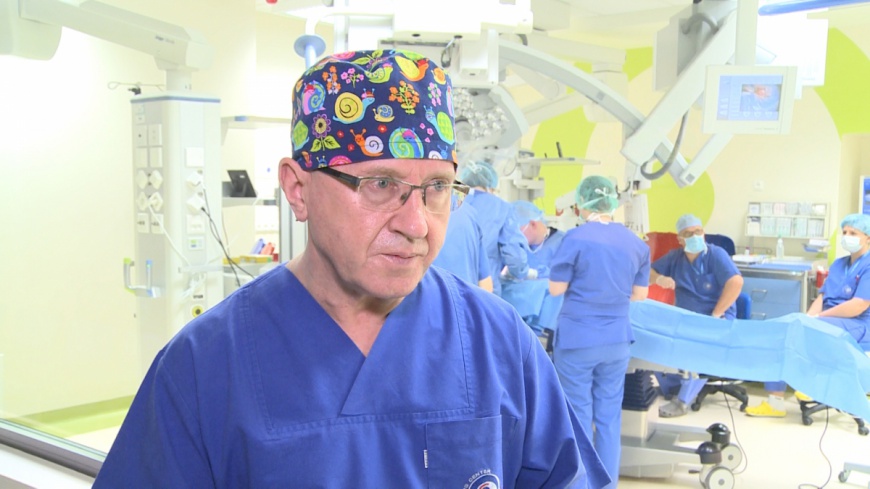| Says: | Professor Henryk Skarżyński |
| Function: | Director of the Institute of Physiology and Pathology of Hearing |
New treatment method for patients with hearing problems. Polish doctors have been the first in the region to implant innovative hearing aids
Polish doctors have been the first in Central and Eastern Europe, and the fourth worldwide, to successfully implant next-generation hearing aids. The aids work on the basis of bone conduction to provide patients with natural and clear hearing experience. This gives hope to patients with hearing disorders in whom other treatments have failed, ENT doctors say.
„This device uses bone conduction. Each of us, when we touch our skull bones, receives sounds; these sounds are transferred to the inner ear and then, through the auditory path, to the central systems,” Professor Henryk Skarżyński, Director of the Institute of Physiology and Pathology of Hearing, explained in an interview for Newseria Biznes.
The new implant, Cochlear OSIA OSI100, is a large step forward in the treatment of hearing disorders. The device is made up of two parts, the first is installed magnetically on the skin, and the second is implanted under the skin. The former receives sounds which are then transferred on the basis of bone conduction to the latter.
„Bone conduction ensures clear sound, which makes whatever patients hear, especially speech and music, sound very natural. This makes listening to music and hearing at low, medium, and high frequencies much more comfortable,” Professor Skarżyński explained.
The new device restores hearing to a level found in healthy people. It will benefit patients in whom previous treatment methods have failed to bring the expected outcomes.
A study conducted at the Institute of Physiology and Pathology of Hearing has shown that the implant can help over a dozen percent patients, especially adults. But the device is only being tested and the target group could potentially be expanded. The surgery carried out at the World Hearing Centre was the first procedure of this kind in Poland and Central and Eastern Europe. So far, such aids have only been implanted in a few countries in the world.
„We are the fourth centre in the world to introduce this procedure to their everyday clinical practice. On the basis of our future observations, we will be analysing and further defining this target group, and possibly also expanding the age range. Today, we are using it in adults, but I believe in the near future it will find applications in teenagers, and perhaps also in children, for whom the development of hearing is very important, especially when they start their education at school,” said the Director of the Institute of Physiology and Pathology of Hearing.
It has been estimated that about 900,000 people in Poland have hearing problems, and 40,000-50,000 can hardly hear anything. This problem is more and more often affecting young people. A recent screening survey has shown that in primary schools as many as one in five or six children have hearing problems that could hamper their learning or interfere with their normal development.
Read also
- 2025-05-16: Diagnostyka zaburzeń snu może być łatwiejsza. Inteligentna piżama monitoruje bruksizm i bezdech senny
- 2025-03-04: Przedsiębiorcy apelują o deregulację i stabilny system podatkowy. Obecne przepisy są szczególnie uciążliwe dla małych i średnich firm
- 2025-03-11: Jerzy Owsiak: Polskie firmy potrzebują, aby państwo im nie przeszkadzało w prowadzeniu biznesu. Ważne jest też zaufanie i ograniczenie biurokracji
- 2025-03-05: Biznes coraz chętniej angażuje się w działania społeczne. To ważny partner dla Wielkiej Orkiestry Świątecznej Pomocy
- 2024-12-19: Polska centralna przyciąga coraz więcej inwestycji. W Łodzi powstaje nowe centrum dystrybucyjne dla Della
- 2024-04-26: T-Mobile startuje w Polsce z nowym konceptem. Pozwoli klientom przetestować i doświadczyć najnowocześniejszych technologii
- 2024-03-01: Krystyna Sokołowska (Miss Polonia 2022): Może po konkursie Miss World otworzą się perspektywy na pracę w telewizji. Chciałabym poprowadzić jakiś program
- 2024-02-26: Krystyna Sokołowska (Miss Polonia 2022): Moim celem podczas konkursu Miss World jest oczywiście korona. Jeżeli będzie to Top 5 czy Top 10, to również będziemy zachwyceni
- 2024-02-19: Krystyna Sokołowska (Miss Polonia 2022): Przygotowywałam się do finału Miss World w Indiach półtora roku. Zgodnie z ideą konkursu skupiłam się na projektach społecznych i charytatywnych
- 2024-01-31: A. Bodnar: Bez naprawy sądownictwa nie będzie inwestycji. Trzeba przywrócić zaufanie przedsiębiorców do sądów i prokuratury
Trade

Polish consumers are more satisfied than Americans, with the customer satisfaction level being close to 80 percent
For six years the customer satisfaction index in Poland has grown by over 17 percentage points to nearly 78 percent, and it currently exceeds the customer satisfaction levels recorded in the USA and the United Kingdom. Service quality and its growing significance among businesses have had a tremendous impact on customer satisfaction. For the eleventh time the Customer Service Quality Star titles have been awarded to entrepreneurs recording the best results in this field.

